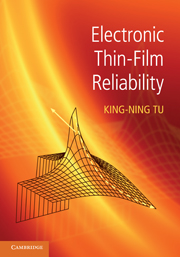Book contents
- Frontmatter
- Dedication
- Contents
- Preface
- 1 Thin-film applications to microelectronic technology
- 2 Thin-film deposition
- 3 Surface energies
- 4 Atomic diffusion in solids
- 5 Applications of the diffusion equation
- 6 Elastic stress and strain in thin films
- 7 Surface kinetic processes on thin films
- 8 Interdiffusion and reaction in thin films
- 9 Grain-boundary diffusion
- 10 Irreversible processes in interconnect and packaging technology
- 11 Electromigration in metals
- 12 Electromigration-induced failure in Al and Cu interconnects
- 13 Thermomigration
- 14 Stress migration in thin films
- 15 Reliability science and analysis
- Appendix A A brief review of thermodynamic functions
- Appendix B Defect concentration in solids
- Appendix C Derivation of Huntington's electron wind force
- Appendix D Elastic constants tables and conversions
- Appendix E Terrace size distribution in Si MBE
- Appendix F Interdiffusion coefficient
- Appendix G Tables of physical properties
- Index
- References
9 - Grain-boundary diffusion
Published online by Cambridge University Press: 05 July 2014
- Frontmatter
- Dedication
- Contents
- Preface
- 1 Thin-film applications to microelectronic technology
- 2 Thin-film deposition
- 3 Surface energies
- 4 Atomic diffusion in solids
- 5 Applications of the diffusion equation
- 6 Elastic stress and strain in thin films
- 7 Surface kinetic processes on thin films
- 8 Interdiffusion and reaction in thin films
- 9 Grain-boundary diffusion
- 10 Irreversible processes in interconnect and packaging technology
- 11 Electromigration in metals
- 12 Electromigration-induced failure in Al and Cu interconnects
- 13 Thermomigration
- 14 Stress migration in thin films
- 15 Reliability science and analysis
- Appendix A A brief review of thermodynamic functions
- Appendix B Defect concentration in solids
- Appendix C Derivation of Huntington's electron wind force
- Appendix D Elastic constants tables and conversions
- Appendix E Terrace size distribution in Si MBE
- Appendix F Interdiffusion coefficient
- Appendix G Tables of physical properties
- Index
- References
Summary
Introduction
Most of the metallic thin films used in microelectronic devices are polycrystalline rather than monocrystalline. Grain-boundary diffusion is of concern. It has caused two very well-known failure modes in Si devices: electromigration in Al interconnects and Al-penetration into Si through diffusion barriers. In electromigration, it is known that voids are formed at the triple point of grain boundaries and extend out along grain boundaries. The topic of electromigration and electromigration-induced failure will be covered in the next two chapters. On Al-penetration, Al forms a pit in Si and short in p-n junction, and also Si precipitates decorate the Al grain boundaries.
In general, atomic diffusion along grain boundaries is faster than in the bulk of grains. This assumes that atoms have a lower activation energy of motion in the boundary and also that vacancy formation within a grain boundary is easier because of the excess volume in the boundary [1–5]. The behavior of grain-boundary diffusion is shown by examining a few experiments.
(1) By comparing tracer diffusivities of Ag* in single crystal Ag and polycrystalline Ag, it has been found that the diffusivity is faster in the polycrystalline Ag at temperatures below 750°C.
(2) Radioactive tracers deposited on a bulk bicrystal show deeper penetration along the grain boundary in auto-radiography images.
(3) We compare thin-film reactions in two sets of Pb/Ag/Au samples: one was epitaxially grown on rock salt and the other was deposited on fused quartz to grow polycrystalline grains.
- Type
- Chapter
- Information
- Electronic Thin-Film Reliability , pp. 192 - 211Publisher: Cambridge University PressPrint publication year: 2010



